-
Content Count
1,757 -
Joined
-
Last visited
Content Type
Profiles
Forums
Gallery
Articles
Gun Dealer's and Fieldsports Shop's
Reloading Room
Blogs
Calendar
Store
Classifieds
Posts posted by john b
-
-
You can make one virtually any size you like, however there are some practicalities that you need to keep in mind.
If you made one with a 2ft x 2ft base and 2ft high for example and put an access door in the middle of the roof, then the distance from that door to the corners is about 700mm. That is about the maximum that I can reach to grab a pigeon which is doing it's best to get as far away as possible. In my view anything bigger than that goes into a sort of operation no-mans land where it's too big to reach into fully, but too small to get inside. I think the minimum height for a physical entry trap would be 4 or 5ft.
Having said that there are techniques for dealing with that middle ground if you want to go that route. How would you feel about using some sort of net or grab pole ? It's also possible to build in some sort of dynamic divider which can be swung down to split the cage into two and corral the birds into one end.
There's also the question of how much the height and the perch is important in attracting in other birds - I think height is important for large catches.
-
go on here he has a video on making and setting snares http://www.fourteena...creTrapShop.htm DEGSY
Thanks for the plug
 This is a better link Woodga Rabbit Snaring
This is a better link Woodga Rabbit Snaring -
I can help you out with that - but wait until you're in the UK and get in touch then. No point sending it all the way out there just for you to bring it back again.

-
Actually, while we're on the subject, the latest edition of the Snaring Practitioners Guide has just been published - edition 3
Anyone snaring in Scotland should have a good read of this, whether you agree with it or not.

-
-
That's a difficult one to answer Mike. It was originally set up as a baited trap but that was some time ago - I think between them the mice, the slugs and the ants will have had the bait away long since.
However it was never placed as a run-through (as you'll see in the pic below) and has the 'under and over' baffles that mean it doesn't look like a run-through from ground level. I stopped using run-throughs some time ago in this location because we had a lot of hedgehogs, some of which seemed very determined.
I think there may have been some vestiges of the bait scent still there and having been in place for so long it had just become part of the terrain to be explored.
-
I was reminded today about the benefits of having a few traps about the place, set in a safe and discreet manner. And of the importance of checking them.
My neighbour has a large area of decking at the end of his garden, not properly sealed off at the edges and a perfect location for nesting rats. The latest infestation was dealt with during the summer but I have a few MK4s about the place in boxes - ideal for keeping the dog and the kids out of it.
Looks like there was a new tenant taking a look. I just hope he was the advance party and not a new resident.
It also looks like I need to swap that Fenn out for a bit of TLC - it's been a wet summer and permanent sets can get into a pretty bad condition.
-
Sounds like a job for the collarum
edited to add that these are available in the UK from several suppliers, although not cheap.
-
I'm surprised that the flatpack ones need any tuning - the ones I've had from them have always been pretty well set. Having said that I do still bend the triggers a little, about halfway down and back towards the end of the trap.
-
I think that this is a great idea for a competition. There are a lot of really ingenious things being made out there and often of a surprisingly high quality. Over the summer I added the Craftsmens' Marketplace to the Fourteenacre shop, precisely to try and showcase these kind of ideas and products.
If it helps to generate a bit more interest in this topic I'd like to add to the prize pot. One of our first Craftsmen's products are some really excellent snare / trap securing cables, made by a lad who really knows his way round an engineering bench.
So I'll throw in a set of five, 3ft cables, terminated in the style of the winner's choosing: either loop/loop, loop/swivel or swivel/swivel.
-
Davy
Have a look at this topic which covers similar ground.
http://www.thehuntin...post__p__141973
The general position is that it is legal to use a Larsen Trap in the UK provided that you comply with the general licenses.
These state a number of things: the reason that you are trapping, your responsibilities to the call bird and the caught birds and that you have the land owners permission. I think this last point would rule out Common land.
In your case the license would be GL08 'To kill or take certain birds to conserve flora and fauna (including wild birds)'
http://www.naturalen...8_tcm6-7672.pdf
It would be in your interest to print, read and have to hand a copy of that licence is case you were challenged. Licences vary between England, Wales, Scotland and N.Ireland to make sure you're using the right one. Species allowed can vary as can the conditions (e.g. in Scotland all Larsen traps must be registered)
BASC have a useful page on this too: http://www.basc.org....-pest-birds.cfm
Oh and making them is quite easy if you have a plan to follow. There is a 'how to' topic HERE and there's a book I can recommend ....

-
Let's not forget our own 'King Rat' threads of 2007 and 2008.
The 2007 winner was 19" and there were a fair few approaching that length
http://www.thehuntinglife.com/forums/topic/18090-king-rat-of-2007-shall-we-go-for-it/
http://www.thehuntinglife.com/forums/topic/39669-king-rat-2007-the-winner/
And the 2008 competition got to 19 3/4" in two months, before we lost the judge
http://www.thehuntinglife.com/forums/topic/39793-king-rat-2008-the-official-thread/
-
As Nod says, it's a fairly simple trigger arrangement.
(Extract from Trap Making, Step by Step)
The trigger uses a long straight rod attached to the side of a strip of mesh or metal, which in turn is pivoted on the trap floor as a treadle. To set the trap, the door is swung up and the treadle tilted so that the end of the rod slides through the door and the roof of the trap together. Poked through both meshes like this the rod keeps the door open.
Bait is put at the back of the trap, well behind the treadle and not under it. Any animal trying to reach the bait will push or tread on the treadle, which will pivot down, pulling the rod and releasing the door. In practice it is usually necessary to trim some of the mesh squares tocreate an elongated rectangle in the door so that the rod can fall away cleanly.
-
I think a read of this might be useful to you too:
http://www.thehuntinglife.com/forums/topic/43368-tunnel-trapping/
-
im sure john b sells them give him a pm
No - I sell the wire but not the made up snares.
You need Trapworks, or Woodga for that
-
If you contact the environment agency they'll send you a tidy little pack all about crayfish trapping.
In includes:
-
Everything you need to apply for a licence (
 )
)
- A handy splashproof guide on identiying the different types of freshwater crayfish
- Tips on how and where to set your traps.
Crayfish trapping advice packs are available from the National Fisheries Laboratory 01480 483968.
http://www.environment-agency.gov.uk/homeandleisure/recreation/fishing/38045.aspx
-
Everything you need to apply for a licence (
-
500g would give you enough to make approximately 75, 6 strand rabbit snares.
The reels have a diameter of about 80mm, getting larger as the wire is wound on top of itself.
-
I have got a snare wire available, in a range of spool sizes, as well as Woodga's DVD which might help fill in a few of the gaps for you.
http://www.fourteenacre.pwp.blueyonder.co.uk/shopindex_files/FourteenacreSnarewire.htm
cheers
John
-
Yep - going Friday.
-
I can't quite make out the pictures, but is that a tunnel where the can is ? with a hole in the floor down into the main cage ?
Can you take a photo from directly above and another looking down at an angle
And why do you think it's a trap ? Could it just be a bird or chinchilla cage ?
-
-
I've never had any problems with the ones I use and sell.
As you mention having frequent issues with the springs it's worth pointing out that they have to be fitted the right way. They need to be already under tension when the door is closed and fitted so that as the door is set open, it winds the coil up more.
I'm not saying that you are fitting yours incorrectly, but thought it was worth a mention.

-
Sound a bit like it might be a bait box of some sort - used for rat poison
-
Fascinating to see them on sale like that - obviously still a real part of the way of life there. Not legal in the UK though as you might imagine.
I know them as French bird traps but I think they are common all over mainland Europe as bird and mouse traps. The base of the trap has a long, narrow loop that extends outwards and has a retaining arm attached to the end of it. The two semicircular jaws are sprung so that when the top one is bent back into the set position the retaining arms folds over and fits into a small loop on the trigger.
Bait can be attached to the trigger so that a sharp tug will release the retainer and the top jaw snaps closed.


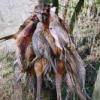





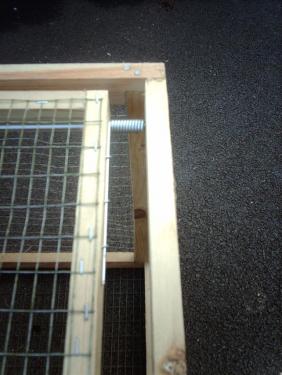
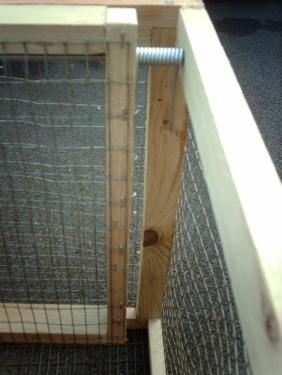
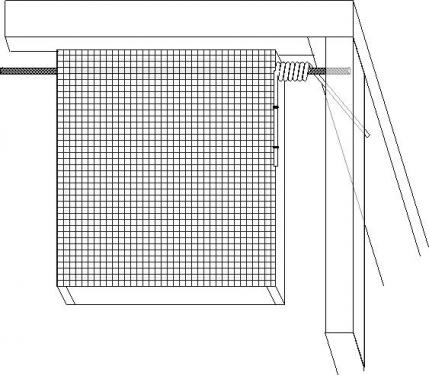
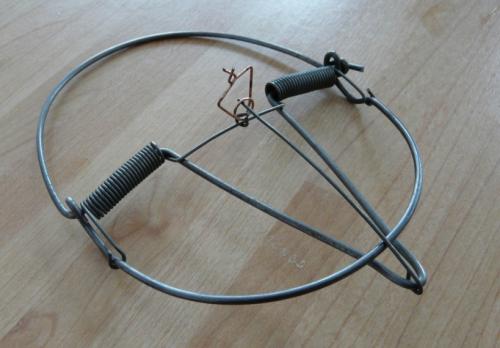
ladder trap dimensions
in Snaring, Trapping & Pest Control
Posted
About 150mm square, smaller than that for Jackdaws.
The old MAFF plans had the spacings hole at 9" square, if you read through this thread http://www.thehuntinglife.com/forums/topic/14348-ladder-trap/